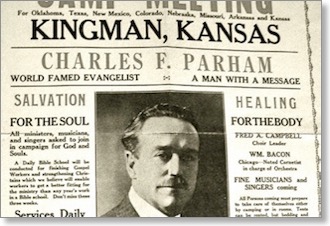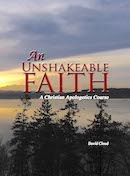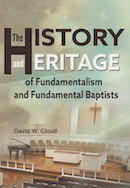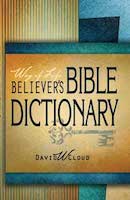866-295-4143, fbns@wayoflife.org

In a restless search for religious instruction he visited the ministries of a number of strange holiness, faith-healing, and Latter Rain teachers, picking up various heresies along the way, which he eventually merged together into his Pentecostal theology.
Prior to the turn of the century, Parham observed the meetings of Benjamin Irwin, founder of the Fire-Baptized Holiness Church, and was deeply influenced by Irwin’s “third blessing” doctrine (the blessing of salvation, the blessing of power, and the blessing of sinless perfection). As we have seen, Irwin taught that it was necessary for the Christian to seek the “baptism of fire” for power and perfection. Pentecostal historian Vinson Synan describes this connection:
“THE FIRE-BAPTIZED HOLINESS CHURCH SERVED AS AN IMPORTANT LINK IN THE CHAIN THAT LATER PRODUCED THE MODERN PENTECOSTAL MOVEMENT. By teaching that the baptism of the Holy Ghost was an experience separate from and subsequent to sanctification, it laid the basic doctrinal premise of the later movement. It is probable that Charles F. Parham, the man who initiated the Pentecostal revival in Topeka, Kansas, in 1901, received from Irwin the basic idea of a separate baptism of the Holy Ghost following sanctification. Indeed, for a time in 1899, Parham promoted the ‘baptism of fire’ in his Apostolic Faith magazine” (Synan, The Holiness-Pentecostal Tradition, p. 59).
Parham adopted the heresy of annihilation from his Quaker grandfather-in-law, David Baker, denying the eternal punishment of the wicked and believing, rather, that the unsaved would be annihilated in hell.
In 1898, Parham came under the influence of the aforementioned Frank Sandford, and in 1900 Parham traveled to Chicago to study the ministry of John Dowie and to examine Zion City.
Like Sandford and Dowie, Charles Parham taught that physical healing is the Christian’s birthright and railed against the use of medicine and doctors. He claimed that it was always God’s will to heal sicknesses. In the September 13, 1899, issue of his Apostolic Faith magazine, Parham replied to the question of whether the Bible forbids the use of medicine by exclaiming, “We say yes, most emphatically YES” (emphasis his).
An issue of Christian History magazine (Issue 58, Vol. XVII, No. 2, 1998) contains a photo of Parham and seven of his followers standing on the steps of the Carthage, Missouri, courthouse. The year was 1906, and Parham is holding a flagpole with banners reading “Apostolic Unity.” The others are holding banners proclaiming “Truth, Faith, Life, Victory, HEALTH.” They were making a statement of their doctrinal faith that health is a guaranteed part of the Christian life.
Parham was the first Pentecostal preacher to pray over handkerchiefs and mail them to those who desired his ministrations (James Goff Jr., Fields White Unto Harvest, p. 104).
In spite of his teaching that it was always God’s will to heal and that medicine and doctors must be shunned, one of Parham’s sons died at age one of a sickness that was not healed. He died, in fact, two months after the outbreak of “tongues” at Parham’s Bethel Bible School in Topeka. Another son died at age 37. Most of those who attended Parham’s meetings were not healed. In October 1904, a nine-year-old girl named Nettie Smith died. Her father was an avid follower of Parham and refused medical treatment for his daughter. The little girl’s death turned local public opinion against Parham because her sickness was treatable and the community considered her death unnecessary.
Parham himself suffered various sicknesses throughout his life and at times was too sick to preach or travel. For example, he spent the entire winter of 1904-05 sick and bedridden (James Goff Jr., Fields White Unto Harvest, p. 94), in spite of his own doctrine that healing is guaranteed in Christ’s atonement.
In the March 22, 1899, issue of Apostolic Faith magazine Parham listed his beliefs as follows: “salvation by faith; healing by faith, laying on of hands, and prayer; sanctification by faith; coming (pre-millennium) of Christ; the baptism of Holy Ghost and Fire, which seals the Bride and bestows the gifts.”
Thus we see the combination of the various heresies he had collected in his travels.
Parham also believed in the annihilation of the unsaved. He taught that there were two separate creations, and that Adam and Eve were of a different race than people who allegedly lived outside of the Garden of Eden. The first race of men did not have souls, he claimed, and this race of people without souls was destroyed in the flood. Parham believed that only those who received the latter day Spirit baptism and spoke in tongues would make up the bride of Christ and would be “sealed for the Marriage Supper of the Lamb” and that these would have a special place of authority at Christ’s return. He believed in a partial Rapture composed of tongues speakers.
From John Dowie, Parham adopted the heresy that Anglo-Saxons are Israelites.
He associated often with the Ku Klux Klan and believed that interracial marriages caused the flood of Noah (Martin, The Topeka Outpouring of 1901, p. 19). Parham did not believe that black people could be sealed as part of the bride of Christ.
After his visits with Dowie and Sandford, Parham established the BETHEL BIBLE SCHOOL IN TOPEKA, KANSAS. It was patterned after Sandford’s ministry and was opened in October 1900 in a thirty-room building called “Stone’s Folly.” It was so named because the owner, whose name was Stone, was unable to complete the building before going bankrupt.
Parham was convinced that Christ’s return would be preceded by a Latter Rain outpouring of signs and wonders, and he believed that tongues is the evidence of the baptism of the Holy Spirit. He further believed that the tongues are real earthly languages that would enable missionaries to preach the gospel to the ends of the earth without having to learn foreign languages. According to Parham’s teaching, those who received the Latter Rain baptism would form the bride of Christ and would rule with Him at His coming.
Parham urged his students to seek this experience, and in this context he laid hands on one of his Bible school students, AGNES OZMAN, on January 1, 1901, and she allegedly began to speak in Chinese and later in Bohemian. She spoke while in a trance (Topeka State Journal, Jan. 9, 1901).
Subsequently, Parham and others at the small Bible school also allegedly began to speak in tongues. They even claimed that cloven tongues of fire appeared over the heads of the tongues speakers.
Parham said that language professors and other linguistically educated people confirmed that the tongues the students were speaking were languages, but this has never been confirmed. Newspaper reporters of the day described the phenomenon merely as “gibberish.”
The only actual record we have of one of the “tongues” spoken by Parham’s students was written by a reporter of the Topeka State Journal. I found a copy of this during a visit to the Kansas State Historical Society.
“Mr. Parham called Miss Lilian Thistlethrate [Thistlethwaite] into the room and asked her if she could talk some. She at first answered that the Lord had not inspired her to say anything but soon began to utter strange words which sounded like this: ‘Euossa, Euossa, use rela sema calah mala kanah leulla ssage nalan. Ligle logle lazie logle. Ene mine mo, sah rah el me sah rah me.’ These sentences were translated as meaning, ‘Jesus is mighty to save,’ ‘Jesus is ready to hear,’ ‘and ‘God is love’” (“Hindoo and Zulu Both Are Represented at Bethel School,” Topeka State Journal, Jan. 9, 1901).
Ligle logle lazie logle!!!!! Ene mine mo!!!!! This is exactly the type of “tongues” I have heard dozens of times at Pentecostal and charismatic meetings in various parts of the world, but it is childish nonsense.
In 1914, Charles Shumway diligently sought evidence to prove that early Pentecostal tongues were real languages, but he failed to find even one person to corroborate the claims that had been made (James Goff, Jr., Fields White Unto Harvest, Fayetteville: University of Arkansas Press, 1988, p. 76).
“In his 1919 Ph.D. dissertation, Shumway censured the local Houston Chronicle for credulous reporting and stated that ‘letters are on hand from several men who were government interpreters in or near Houston at the time [when Parham conducted a Bible school there], and they are unanimous in denying all knowledge of the alleged facts’” (Goff, p. 98).
After examining the “tongues” spoken at the Azusa Street mission led by William Seymour, Holiness leader W.B. Godbey concluded that they were not languages (G.F. Taylor, The Spirit and the Bride, Falcon, NC: by the author, 1907, p. 52).
The Rocky Mountain Pillar of Fire (a holiness publication) for September 12 and November 14, 1906 contained the following accounts:
“This Hindu can talk in six different languages and says he has never heard any of them at the ‘Tongue meeting.’ One of the languages he can talk is Arabian and some of the people at those meetings claim to talk that language, but he said it sounded like a lot of turkey gobblers” (Sept. 12, 1906).
“A gentleman, who has for years been at the head of a missionary work in India, has just been to Los Angeles with the view of securing some missionaries for his field who profess to have the gift of tongues. He came back stating he could find no one who could really speak in any of the languages of India with which he is acquainted” (Nov. 14, 1906).
Many linguists who have studied the “tongues” of Pentecostals and Charismatics have come to the same conclusion. William J. Samarin, professor of linguistics at the University of Toronto, summarized his research as follows:
“Over a period of five years I have taken part in meetings in Italy, Holland, Jamaica, Canada, and the United States. I have observed old-fashioned Pentecostals and neo-Pentecostals; I have been in small meetings at private homes as well as in mammoth public meetings; I have seen such different cultural settings as are found among the Puerto Ricans of the Bronx, the snake handlers of the Appalachians ... Russian Molakans in Los Angeles. ... It is extremely doubtful that the alleged cases of xenoglossia [languages] among charismatics are real. Any time one attempts to verify them he finds that the stories have been greatly distorted or that the ‘witnesses’ turn out to be incompetent or unreliable from a linguistic point of view. ... GLOSSOLALIA IS INDEED LIKE LANGUAGE IN SOME WAYS, BUT THIS IS ONLY BECAUSE THE SPEAKER (UNCONSCIOUSLY) WANTS IT TO BE LIKE LANGUAGE. YET IN SPITE OF SUPERFICIAL SIMILARITIES, GLOSSOLALIA IS FUNDAMENTALLY NOT LANGUAGE” (Samarin, Tongues of Men and Angels, 1972, pp. xii, 112, 113, 227).
The Gospel Message, published in Kansas City, in October 1906, contained the following testimony:
“We were acquainted with Mr. Chas. Parham many years ago, and when he visited Kansas City with his workers after he had made his statements regarding the wonderful blessing that had come to his school in Topeka, we invited him to visit us with his followers and tell us about this experience. They accordingly came, and before the meeting we told him that there were those present that could speak Spanish, German, Arabic, and Swedish, and that if any of his people could speak in other tongues, we would be glad to hear them in one or more of these: they had, however, no liberty that night but told something of their past experience, and their strange writings which had been reported as the work of the Holy Spirit. When, however, we asked Mr. Parham pointedly and publicly if he knew certainly whether these writings were of the Holy Spirit, or just scribblings, he candidly said he did not know, but that he was having them, or would have them, investigated, but a report of such investigation has never reached us” (reprinted from Larry Martin, Skeptics and Scoffers, pp. 47-48).
This reminds us that every time someone attempts to test Pentecostal tongues or healings or other “signs and wonders” objectively, the phenomena prove to be either completely bogus or strangely illusive. The most amazing signs and wonders always occur some place far away or long ago and are otherwise not verifiable.
I visited the Kansas State Research Library in Topeka in 2002 and got a photo of the building where Parham had his Bible School. (It was destroyed by a fire in December 1901). I also found some old newspaper articles and other documents about Parham’s school, which I cite in the following part of this report.
Two articles give the testimony of S.J. Riggins, a student who left the school, claiming that the other students were merely speaking “gibberish.”
“‘I believe the whole of them are crazy,’ said Mr. Riggins to a Capital reporter. ‘I never saw anything like it. They were racing about the room talking and gesticulating and using this strange and senseless language which they claim is the word from the Most High. ... I do not believe their senseless jargon means anything. I am trying to be an earnest Christian. ... When I left the congregation today, I told why I did so, with all the earnestness at my command.’ ... Mr. Riggins said that some of Miss Auswin’s [Ozman’s] writing, which she claimed to be inspired, was submitted to a Chinaman here in Topeka with the honest intention of seeing if he could translate it. The Celestial threw up his hand and said: ‘Me no understand. Takee to Jap.’ Mr. Riggins told this story without a suspicion of levity and if he put any humor in it at the last it was done unconsciously, for he seemed terribly in earnest” (Topeka Daily Capital, Jan. 6, 1901).
“‘They began to claim the gift of tongues and the gift of discernment, and each talked a different kind of gibberish, claiming to be inspired by God, and that they talked one of the foreign languages. ... I was not under the influence, and could see that the students of the school had been led to this extreme through their fanaticism, and finally decided to leave the school. Accordingly last Saturday morning I went away, but before going, I called the inmates of the building together and explained to them my reasons for leaving. I told them they were under the influence of the evil one, and that the best thing they could do would be to leave the school, as I was doing. They all laughed at me, and I left the school, and do not intend to return.’...
“About fifteen members of the colony have now been given the gift of tongues and when a State Journal reporter called at the school this morning each of the favored ones were called up and spoke a few sentences in strange and unnatural way outlandish words which they neither know the meaning of nor the language to which they belonged. ... It is a peculiar sight to see a whole room full of the men and women of the school sitting around, occasionally breaking out with brief outbursts of talk in one of the many languages which they claim to speak, and writing the quaint and indistinguishable hieroglyphics which they believe to be the characters for words in the Syrian, Chinese, Japanese, Arabic and other languages” (Topeka State Journal, Jan. 7, 1901).
We are convinced that Riggins was correct in his assessment that Parham and his students were speaking gibberish and practicing fanaticism under the influence of the evil one.
Consider this description by Parham of what his students were doing the day after Ozman began her tongues speaking career:
“The next day I went down town and upon my return found ALL THE STUDENTS SITTING ON THE FLOOR TALKING IN UNKNOWN TONGUES, NO TWO TALKING THE SAME LANGUAGE, AND NO ONE UNDERSTANDING HIS OR HER NEIGHBOR'S SPEECH” (Topeka Mail and Breeze, Feb. 22, 1901).
This is strictly contrary to the Bible’s instruction about the use of tongues. The Bethel Bible School “tongues” in January 1901 was confusion, which the Bible says is not of God (1 Cor. 14:33). The Bible says that tongues are not to be used unless they are interpreted and even then, the gift is to be exercised by only one speaker at a time (1 Cor. 14:23-28). Further, women are not to speak (1 Cor. 14:34).
Parham claimed that Ozman was unable to speak in English for three days after her initial tongues experience. Her own testimony was that “many times we could only talk in other tongues” (Martin, The Topeka Outpouring of 1901, p. 88).
To the contrary, the Bible says a genuine prophet or tongues speaker is in control of himself. “And the spirits of the prophets are subject to the prophets” (1 Cor. 14:32).
Ozman’s uncontrollable “tongues” were not of God.
The lack of control over the “tongues” was also described by Lillian Thistlethwaite, another student at Parham’s Bible school.
“My tongue began to get thick and great floods of laughter came into my heart. I could no longer think words of praise, for my mind was sealed, but my mouth was filled with a rush of words I didn’t understand. I tried not to laugh for I feared to grieve the Spirit. I tried to praise Him in English but could not, so I just let the praise come as it would in the new language...” (Martin, The Topeka Outpouring, p. 61).
This is contrary to what we see in the book of Acts and the Epistles.
As we have seen in the previously quoted newspaper accounts, Parham’s students not only claimed to speak in tongues but also to write in them. They claimed these writings were foreign languages, such as Chinese, but when they were examined by knowledgeable people, they were found to be mere indecipherable scratchings (Goff, p. 76).
The Topeka Daily Capital printed an example of Ozman’s “inspired writings,” and it can still be seen in the Kansas State Research Library. It was nothing more than childish scratchings. The people were deluded, plain and simple. The press called the writings “quaint and indistinguishable hieroglyphics” (Goff, p. 80).
A reporter for the Topeka State Journal observed Agnes Ozman when she was allegedly writing by inspiration:
“Miss Ozman sat at a desk writing some letters which were to be posted that morning. Shortly after finishing the letters she sat down to write again and immediately announced that her hands utterly refused to write the characters of the English language. And with her hands unconsciously formed the characters of some language, but she was not able to state which. She did not interpret the marks. IN WRITING THE CHARACTERS, THE MUSCLES OF MISS OZMAN’S HANDS SEEM TO CONTRACT AND SHE MADE THE MARKS IN A SPASMODIC FASHION, HER HAND RATHER JERKING BACK AND FORTH to make the scrawls” (“Hindoo and Zulu Both Are Represented at Bethel School,” Topeka State Journal, Jan. 9, 1901).
This is the same phenomenon that occurs with New Age automatic writing, which is clearly demonic. There is not a hint of such a thing in the New Testament Scriptures.
The early Pentecostals thought they would be able to preach in foreign languages through the gift of tongues. Parham is quoted as follows in a newspaper article from that day:
“It is a wonderful work, coming as it does on the eve of the twentieth century. We have for long believed that the power of the Lord would be manifested in our midst, and that power would be given us to speak other languages, and that the time will come when we will be sent to go into all the nations and preach the gospel, and that THE LORD WILL GIVE US THE POWER OF SPEECH TO TALK TO THE PEOPLE OF THE VARIOUS NATIONS WITHOUT HAVING TO STUDY THEM IN SCHOOLS” (Topeka State Journal, Jan. 7, 1901).
“We have received several messages to go into all the world and preach the gospel, and we must obey the command. A PART OF OUR LABOR WILL BE TO TEACH THE CHURCHES THE USELESSNESS OF SPENDING YEARS OF TIME PREPARING MISSIONARIES FOR WORK IN FOREIGN LANDS WHEN ALL THEY HAVE TO DO IS TO ASK GOD for power and then have faith that the power will come” (Parham, quoted in Kansas City Times, Jan. 27, 1901).
As it turned out, they were deceived in this as they were in everything else.
Alfred Garr and his wife went to India expecting to speak in supernatural languages, but they quickly learned that it was a delusion. May Law and Rosa Pittman went to Japan expecting to preach in Japanese; but when they found that no one could understand their “tongues,” they moved on to Hong Kong, thinking that they must have the gift of Chinese instead, but they were no more successful there. T.J. McIntosh was the first Pentecostal missionary to Macau, and though he fully expected to speak fluent Chinese, his hopes were soon dashed.
“Numerous other Pentecostal missionaries went abroad believing they had the miraculous ability to speak in the languages of those to whom they were sent. These Pentecostal claims were well known at the time. S.C. Todd of the Bible Missionary Society investigated eighteen Pentecostals who went to Japan, China, and India ‘expecting to preach to the natives in those countries in their own tongue,’ and found that by their own admission ‘in no single instance have [they] been able to do so.’ AS THESE AND OTHER MISSIONARIES RETURNED IN DISAPPOINTMENT AND FAILURE, PENTECOSTALS WERE COMPELLED TO RETHINK THEIR ORIGINAL VIEW OF SPEAKING IN TONGUES” (Robert Mapes Anderson, Vision of the Disinherited: The Making of American Pentecostalism).
Parham’s Bible school in Kansas closed down within months, and he moved to Texas to establish churches. He also started a new Bible school in Houston.
- Receive these reports by email
- www.wayoflife.org
______________________
Sharing Policy: Much of our material is available for free, such as the hundreds of articles at the Way of Life web site. Other items we sell to help fund our expensive literature and foreign church planting ministries. Way of Life's content falls into two categories: sharable and non-sharable. Things that we encourage you to share include the audio sermons, O Timothy magazine, FBIS articles, and the free eVideos and free eBooks. You are welcome to make copies of these at your own expense and share them with friends and family. You may also post parts of reports and/or entire reports to websites, blogs, etc as long as you give proper credit (citation). A link to the original report is very much appreciated as the reports are frequently updated and/or expanded. Things we do not want copied and distributed are "Store" items like the Fundamental Baptist Digital Library, print editions of our books, electronic editions of the books that we sell, the videos that we sell, etc. The items have taken years to produce at enormous expense in time and money, and we use the income from sales to help fund the ministry. We trust that your Christian honesty will preserve the integrity of this policy. "For the scripture saith, Thou shalt not muzzle the ox that treadeth out the corn. And, The labourer is worthy of his reward" (1 Timothy 5:18). Questions? support@wayoflife.org
Goal:Distributed by Way of Life Literature Inc., the Fundamental Baptist Information Service is an e-mail posting for Bible-believing Christians. Established in 1974, Way of Life Literature is a fundamental Baptist preaching and publishing ministry based in Bethel Baptist Church, London, Ontario, of which Wilbert Unger is the founding Pastor. Brother Cloud lives in South Asia where he has been a church planting missionary since 1979. Our primary goal with the FBIS is to provide material to assist preachers in the edification and protection of the churches.
Offering: Offerings are welcome if you care to make one. If you have been helped and/or blessed by our material offerings can be mailed or made online with with Visa, Mastercard, Discover, or Paypal. For information see: www.wayoflife.org/about/makeanoffering.html.





